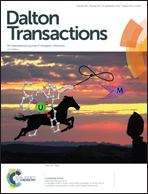Copper(ii)-benzimidazole complexes as efficient fluorescent probes for l-cysteine in water†
Abstract
Copper(II) complexes [Cu(L1)(H2O)2](SO3CF3)21 and [Cu(L2)(H2O)2](SO3CF3)22 based on 2,6-bis(benzimidazolyl)pyridine were synthesized and are reported herein as highly selective “turn-on” optical probes for L-cysteine. The Cu(II)/Cu(I) redox potential of probe 1 (0.14 V vs. NHE) was lower than that of 2 (0.233 V vs. NHE) in water. The molecular structure of 2 adopted a square pyramidal geometry (τ = 0.2545), with the Cu–Npy bond (1.958 Å) of its middle pyridine unit being shorter than the other two Cu–Nbenzim bonds (Cu–N, 1.995, 2.000 Å). The axial Cu–O2 bond distance (2.247 Å) was slightly longer than the equatorial Cu–O1 bond distance (1.953 Å). The square-based geometry was further supported by the A∥ value of 156 × 10−4 cm−1 in EPR at 70 K. The d–d and ligand-based transitions appeared at 662 and 314–356 nm for 1 and 651 and 313–360 nm for 2, respectively, in HEPES buffer at pH 7.34. These probes showed selective and efficient “turn-on” fluorescence behaviour towards Cys over other natural amino acids with a binding constant for 1 of 5.4 × 104 and 1.30 × 104 M−1 for 2 and a limit of detection of 2.9 × 10−8 M and 3.32 × 10−8 M, respectively, for 1 and 2 at pH 7.34. The quantum yield for the detection of Cys by 1 (14.7%) was much lower than by 2 (23%). The fluorescence intensity of 1 and 2 were also slightly enhanced by histidine, but at a relatively lower level than that exhibited by Cys.



 Please wait while we load your content...
Please wait while we load your content...